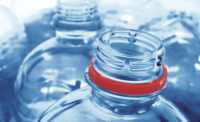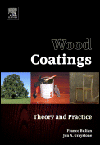High-Performance "Green" Pretreatment
A new automotive pretreatment technology addresses environmental concerns and offers cost-saving advantages while also meeting the performance requirements of today’s automakers. The pretreatment is based on technology that uses a proprietary blend of additives and zirconium-based chemistry to deposit a zirconium oxide conversion coating on clean metal surfaces.

For decades, automakers have turned to phosphate-based technologies for their pretreatment needs - and with good reason. Tricationic zinc phosphate conversion coatings predictably and reliably deliver protection against corrosion, and years of process and chemistry refinements have generated pretreatment products with excellent paint-adhesion properties.
However, these products are not free from drawbacks. Sludge produced as a byproduct of the zinc phosphate pretreatment process contains heavy metals such as nickel, zinc and manganese, and discharge of this sludge is limited due to increasingly strict environmental regulations. In addition to creating challenges in the handling and disposal of the sludge, the presence of heavy metals in the process also results in significant wastewater management concerns.
To meet the needs of automakers worldwide, researchers at PPG Industries have developed a new pretreatment system* that not only addresses environmental concerns, but also offers economic advantages while delivering the high performance that automotive manufacturers require. The pretreatment is based on technology that uses a proprietary blend of additives and zirconium-based chemistry to deposit a zirconium oxide conversion coating on clean metal surfaces.
Global production capacity for zinc is rapidly being outpaced by growth in the demand for galvanized steel and a myriad of other products that require zinc. As a result, there is substantial pressure on zinc suppliers worldwide. By using chemistry based on zirconium - a more economically stable raw material - as opposed to traditional zinc phosphate chemistry, the new pretreatment removes uncertainty regarding the zinc supply and provides a more secure alternative.

The new pretreatment also has the potential to increase efficiency and generate additional cost savings in production. Specifically, its chemistry allows for the use of ambient-temperature baths that require minimal agitation and fewer rinse cycles than the current processes (see Figure 1). As a result, using the new zirconium-based pretreatment could lead to substantial energy savings on the production line.
Estimates show that, depending on the manufacturing footprint, there is potential for annual savings of up to several hundred thousand dollars with the use of the new pretreatment due to reductions in associated costs, such as energy, maintenance and labor. Potential savings are even greater in greenfield applications, where fewer process stages could generate up to several million dollars in savings on new facility capital investments.
The new pretreatment is an environmentally responsible, “green” solution that addresses regulatory concerns and delivers economic incentives.

Using standard automotive testing protocol such as cyclic corrosion, water soak and chipping adhesion tests, PPG researchers have demonstrated that the performance of the new zirconium-based pretreatment is at least equivalent to the tricationic zinc phosphate technologies currently used throughout the industry. The pretreatment is also colored to allow visual confirmation of application.
For several years, the development of an alternative, “greener” pretreatment technology was focused on optimizing the anti-corrosion performance on cold-rolled steel, while maintaining excellent corrosion protection on zinc and aluminum alloys used in the auto industry. Based on recent findings, the new pretreatment approaches the anti-corrosion performance of industry-standard zinc phosphate on cold-rolled steel (see Figure 2). This breakthrough has brought the product closer to commercialization.
The presence of multiple metal substrates in automotive bodies in white adds another level of complexity to the application of alternative pretreatment. Specifically, the zirconium process produces free fluoride, the presence of which must be controlled in order to preserve the integrity and performance of a pretreatment bath. The new zirconium pretreatment is formulated to control free fluoride easily, and the result is a multi-metal friendly product. This characteristic is especially important given the increasing amount of aluminum used in today’s automotive applications.
“Continued leadership in the use of environmentally friendly technologies is imperative at General Motors,” said GM global process pretreatment lead Kevin Cunningham. “[This] innovative pretreatment coating material offers many advantages, including energy savings, water conservation and a smaller footprint. GM is aggressively pursuing global implementation opportunities.”
According to Tim Weingartz, manager of paint materials and strategy at Ford, “Pretreatment is an important anti-corrosion step in the paint process, but the conventional method is harder on the environment. With this new pretreatment technology, Ford continues to lead the industry in environmental solutions to manufacturing processes.”
*The new pretreatment system is available under the tradename Zircobond™ from PPG Industries, Inc. For more information, visit www.ppg.com.

For decades, automakers have turned to phosphate-based technologies for their pretreatment needs - and with good reason. Tricationic zinc phosphate conversion coatings predictably and reliably deliver protection against corrosion, and years of process and chemistry refinements have generated pretreatment products with excellent paint-adhesion properties.
However, these products are not free from drawbacks. Sludge produced as a byproduct of the zinc phosphate pretreatment process contains heavy metals such as nickel, zinc and manganese, and discharge of this sludge is limited due to increasingly strict environmental regulations. In addition to creating challenges in the handling and disposal of the sludge, the presence of heavy metals in the process also results in significant wastewater management concerns.
To meet the needs of automakers worldwide, researchers at PPG Industries have developed a new pretreatment system* that not only addresses environmental concerns, but also offers economic advantages while delivering the high performance that automotive manufacturers require. The pretreatment is based on technology that uses a proprietary blend of additives and zirconium-based chemistry to deposit a zirconium oxide conversion coating on clean metal surfaces.
Global production capacity for zinc is rapidly being outpaced by growth in the demand for galvanized steel and a myriad of other products that require zinc. As a result, there is substantial pressure on zinc suppliers worldwide. By using chemistry based on zirconium - a more economically stable raw material - as opposed to traditional zinc phosphate chemistry, the new pretreatment removes uncertainty regarding the zinc supply and provides a more secure alternative.

Figure 1. Comparison of a conventional zinc phosphate pretreatment footprint and the new zirconium-based pretreatment footprint.
NOTE: OEM pretreatment process designs can vary from plant to plant and line to line. The above diagram is only one example of a conventional automotive pretreatment process. Introduction of Zircobond technology to a pretreatment line will require a design review by PPG specialists to determine the potential for process optimization.
NOTE: OEM pretreatment process designs can vary from plant to plant and line to line. The above diagram is only one example of a conventional automotive pretreatment process. Introduction of Zircobond technology to a pretreatment line will require a design review by PPG specialists to determine the potential for process optimization.
Benefits of Innovation
A process using the new pretreatment system produces minimal toxic, regulated heavy metals and generates at least 80% less sludge byproduct compared to the standard zinc phosphate pretreatment process. The pretreatment can be used in existing pretreatment lines and is safe for the conventional waste treatment systems in most automotive production facilities following a simple pH adjustment. Pretreatment lines incorporating the new system also require fewer boilouts and stage cleanings. Therefore, in addition to addressing the growing regulatory and environmental concerns surrounding pretreatment technologies, the new zirconium-based pretreatment offers potential cost savings in maintenance and waste disposal.The new pretreatment also has the potential to increase efficiency and generate additional cost savings in production. Specifically, its chemistry allows for the use of ambient-temperature baths that require minimal agitation and fewer rinse cycles than the current processes (see Figure 1). As a result, using the new zirconium-based pretreatment could lead to substantial energy savings on the production line.
Estimates show that, depending on the manufacturing footprint, there is potential for annual savings of up to several hundred thousand dollars with the use of the new pretreatment due to reductions in associated costs, such as energy, maintenance and labor. Potential savings are even greater in greenfield applications, where fewer process stages could generate up to several million dollars in savings on new facility capital investments.
The new pretreatment is an environmentally responsible, “green” solution that addresses regulatory concerns and delivers economic incentives.

Figure 2. The new pretreatment developed by PPG approaches the anti-corrosion performance of industry-standard zinc phosphate on cold-rolled steel.
Proven Performance
Today’s quality control standards are tighter than ever, and the tougher OEM requirements for automotive coatings performance have posed challenges for other zirconium-based pretreatments. The new pretreatment contains a proprietary combination of additives that is the key to making the technology work. The performance of the pretreatment has been evaluated in various testing scenarios to ensure that it can produce the adhesion, corrosion protection and electrocoat compatibility necessary for complex automotive applications.Using standard automotive testing protocol such as cyclic corrosion, water soak and chipping adhesion tests, PPG researchers have demonstrated that the performance of the new zirconium-based pretreatment is at least equivalent to the tricationic zinc phosphate technologies currently used throughout the industry. The pretreatment is also colored to allow visual confirmation of application.
For several years, the development of an alternative, “greener” pretreatment technology was focused on optimizing the anti-corrosion performance on cold-rolled steel, while maintaining excellent corrosion protection on zinc and aluminum alloys used in the auto industry. Based on recent findings, the new pretreatment approaches the anti-corrosion performance of industry-standard zinc phosphate on cold-rolled steel (see Figure 2). This breakthrough has brought the product closer to commercialization.
The presence of multiple metal substrates in automotive bodies in white adds another level of complexity to the application of alternative pretreatment. Specifically, the zirconium process produces free fluoride, the presence of which must be controlled in order to preserve the integrity and performance of a pretreatment bath. The new zirconium pretreatment is formulated to control free fluoride easily, and the result is a multi-metal friendly product. This characteristic is especially important given the increasing amount of aluminum used in today’s automotive applications.
Delivering on Goals
As automakers search for an environmentally responsible, cost-effective, high-performance pretreatment technology, the new zirconium-based system offers a promising solution. Companies such as General Motors and Ford have been working closely with PPG on the development of this technology.“Continued leadership in the use of environmentally friendly technologies is imperative at General Motors,” said GM global process pretreatment lead Kevin Cunningham. “[This] innovative pretreatment coating material offers many advantages, including energy savings, water conservation and a smaller footprint. GM is aggressively pursuing global implementation opportunities.”
According to Tim Weingartz, manager of paint materials and strategy at Ford, “Pretreatment is an important anti-corrosion step in the paint process, but the conventional method is harder on the environment. With this new pretreatment technology, Ford continues to lead the industry in environmental solutions to manufacturing processes.”
*The new pretreatment system is available under the tradename Zircobond™ from PPG Industries, Inc. For more information, visit www.ppg.com.
Looking for a reprint of this article?
From high-res PDFs to custom plaques, order your copy today!





